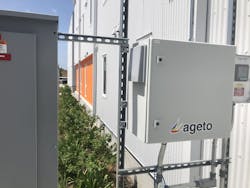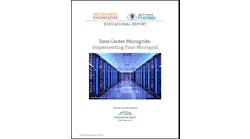Three Microgrid Applications Yield Resilience, Savings, Environmental Benefits
Three microgrid applications that use Ageto Energy controllers demonstrate some of the different ways microgrids can provide benefits–ranging from resilience to energy savings to lower diesel use.
The microgrids serve a Toyota dealership in Colorado, a low-income housing community in New Orleans and a Native American community in Canada.
At Ehrlich Toyota in Greeley, Colorado, the car dealership kept losing business due to numerous and prolonged outages during operating hours. The region’s intense hail storms added to the car dealership’s challenges, leading to high insurance deductibles for car repairs due to hail damage, said Mike Murray, COO of Ageto Energy, which provided the Ageto Renewable Controller. It coordinates and dispatches the energy resources in microgrids to maximize renewable energy penetration.
The Toyota project, engineered by Independent Power Systems, is a 100% renewable grid-tied microgrid consisting of 369 kW of solar from SunPower and 228 kWh of lithium-ion battery storage–with no backup generators. Solar mounted on a new carport slashes insurance deductibles by protecting 80% of the cars, said Murray.
“This implementation allowed us to reduce their loads and provide complete backup for their building with no limitations under solar and two to six hours of operations under battery. We can do this with the additional control strategies as we can shed non-critical loads and continue to evaluate what other loads we can shed as needed,” said Diane Dandeneau, CEO, Ipower Alliance, which provided the solar integrated hail protection.
Toyota experienced multiple outages
The battery is only charged by the solar, and solar provides more than 100% of Toyota’s energy use, which is net metered. This saves the battery for peak shaving and backup power. The battery’s peak shaving capability is managed by DemandEx, a demand management software for microgrids. The same software enabled the microgrid to be installed without a critical loads subpanel.
A car charger will be added, and will be managed by the microgrid, she said.
The most important benefit of the microgrid is resilience, said Murray.
Before the microgrid was installed, the Toyota dealership experienced two to four outages a year.
“You wouldn’t think a car dealership would be impacted by power outages, but the owner had 20 technicians working on cars in the back shop. If the power went out, they were still being paid, and all cars were either stuck in a loft or behind a garage door,” said Murray. In addition, computer terminals went down.
The dealership can now island from the utility and run independently during the day on solar and storage.
“Our customers see the cost of an outage. Saving money on a utility bill is nice but having reliable resilient power is a must for our customers,” he said.
The battery wasn’t designed to run through the night, but the controller system provides real-time information about the amount of energy left in the battery. This way, the dealership knows when it needs to shut the system down and move cars.
The microgrid also lowers demand charges. Initially, demand charges were for 85- to 90 kW, but this year that dropped to 35 kW, thanks to the microgrid and DemandEx software.
Microgrid for net zero community
Resilience and energy savings are important benefits of another Ageto project located at a recently completed low-income housing complex in the New Orleans area, which was hit hard by Hurricane Katrina in 2005.
Developed by SBP, which helps communities rebuild after natural disasters, the St. Peter complex includes 50 units for military veterans and low-to-moderate income families. The project is a net-zero community that includes 450 solar panels and storage that’s expected to generate all of the complex’s energy needs.
The microgrid system is estimated to generate more than $1 million in lifetime energy cost savings, said Ken Faucheux, marketing director, Solar Alternatives, which provided the solar.
“The solar and storage system significantly reduces the operating and maintenance costs of the building, resulting in lower overhead and a lower cost of tenancy,” he said.
The resiliency of the battery system will generate additional savings by ensuring the facility can continue to operate independent of grid outages and reduce expenditures associated with downtime.
The system is grid connected, and designed to minimize the use of the grid and maximize clean energy benefits for the community, said Faucheux.
For the majority of daylight hours, the system sends energy back to the grid, and the net use of energy from the grid is approximately zero.
The system is powered by 100% solar energy, and the battery system helps to maximize self-consumption of solar energy. High efficiency appliances and building systems ensure energy use intensity is low, said Faucheux.
A percentage of the battery will be reserved for outages, and that will vary by time of year based on the threat of storms and power outages. Storage reserves during hurricane season can be as high as 50 %. During seasons less prone to outages, the battery reserve might be 20 %.
Entergy donated $1.1 million for the rooftop solar panels. The Louisiana Housing Corporation and the National Housing Trust Fund also helped finance the project.
The PV system consists of three SMA Core1 PV inverters, for a total of 145 kW. The energy storage is 371 kWh from Dynapower.
The project utilizes net metering but can’t export battery power.
“The control scheme is to charge the batteries with on-site solar power, and then consume the stored solar power once the sun sets. A portion of the energy storage is reserved to power the building during outages,” said Murray. The utility rate structure doesn’t include demand response or time of use options so the project focuses on allowing as much solar as possible to be used on site. The solar and storage contribute to the complex’s ability to reach net zero energy use.
Off grid microgrid in BC
A third project is Harbledown Island, an off-grid microgrid commissioned in April serving the First Nations community in British Columbia. One of the main goals of the project is to reduce diesel use. A few dozen families live on the island, which is located just off Vancouver Island. With solar. energy storage and backup generators, the microgrid allows the community to turn off diesel generators during the day.
The project consists of 120 kW of solar paired with 440 kWh batteries and provides about 10 hours of battery power. The project improves air quality and also eliminates the noise of diesel generators running all day.
Due to the COVID-19 crisis, Ageto wasn’t able to commission the project in person. The company had to improvise and learned how to commission it remotely.
“We thought that because these systems are so complex, our standard procedure is to spend five days on site to make sure everything is working. But with COVID we had to innovate and figure out how to do it remotely.”
With their ability to lower diesel use, cut air pollution, eliminate costly outages and help cut energy costs, the three projects demonstrate the versatility of the mighty microgrid.
Track news about microgrid projects. Subscribe to the free Microgrid Knowledge newsletter.








